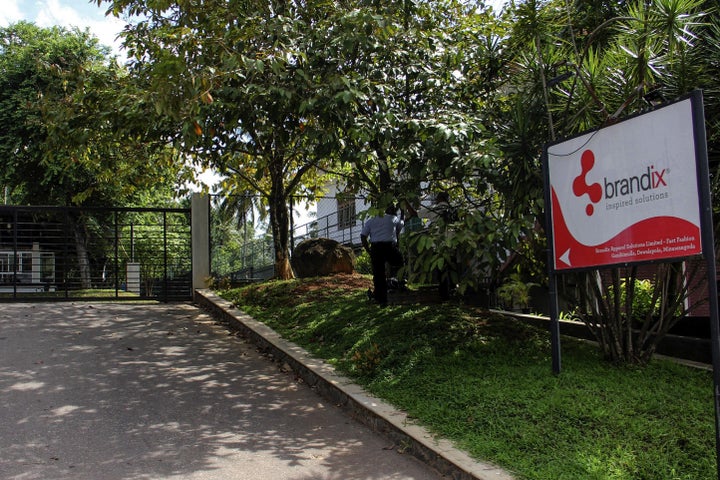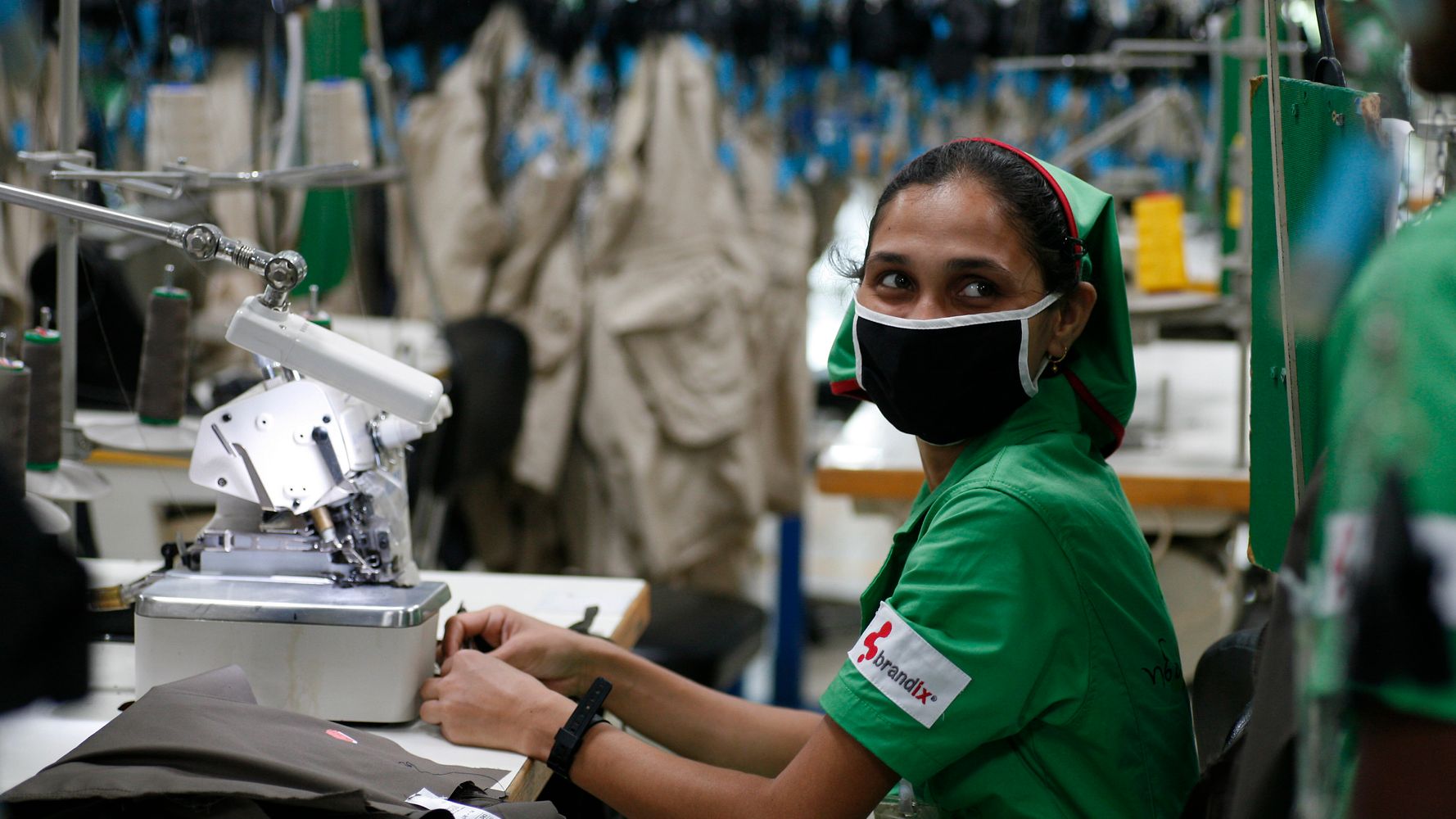[ad_1]
Colombo, SRI LANKA — On October 4 this year, a 39-year-old woman from the Brandix garment factory in Minuwangoda tested positive for COVID-19.
By October 13, Brandix, which makes garments for global brands such as Victoria’s Secret, Gap and Marks & Spencer, was at the heart of an expanding cluster of over 1,500 cases.
Garment workers were immediately ostracised. The family of that first worker diagnosed with Covid was evicted from their rented home, other Brandix employees reported being denied treatment in hospitals. Staff travelling to work in company buses cowered as people threw stones at the vehicle.
For J, a 44-year-old garment worker at the Brandix factory, the realisation that her workplace was now a Covid cluster came freighted with discrimination: Local grocery owners, who know where she works, won’t serve her anymore; she and her fellow workers are not welcome on public transport, wary faces greet her in the neighbourhood. J said she no longer feels comfortable wearing her company T-shirt in public; more often than not, it draws the wrong kind of attention.
Things would get worse: The Brandix factory had spawned a sub-cluster of its own at a regional fish market. Meanwhile, the virus moved quickly through the free trade areas and close-knit neighbourhoods that are home to Sri Lanka’s famous garment industry: other factories in the area reported outbreaks of their own.
By November 11, the Minuwangoda cluster (now renamed the Divulapitiya cluster) and the fish market cluster accounted for over 11,000 cases or over half the national total, according to Sri Lankan authorities. The Brandix Factory at Minuwangoda has been closed since October but Covid-19 has now spread to every one of the island’s 25 districts.
It didn’t have to be like this. Sri Lanka, an island nation of 21 million people, diagnosed its first local Covid-19 case in a tour guide in March (the first reported case was that of a Chinese visitor in January), and quickly went into national lockdown later that month, when the country had fewer than 100 cases. When the lockdown lifted in May, Sri Lanka appeared to have the virus under control. Weddings resumed, people went to watch Tenet, the new Christopher Nolan film, in the theatre and bars re-opened for happy hour.
And then the Brandix Cluster emerged, cases rose sharply, and parts of the island are under lockdown once more.
“I was not scared to report for work after the first wave but now I fear a lot,” said J, explaining that her neighbourhood is one of those under lockdown. “There’s a lot of uncertainty over our health, finance and my job as I have been asked to stay home.”
In a matter of months, Sri Lanka has gone from a success story to a cautionary tale. As policymakers in India, the US and much of Europe grapple with a fresh wave of winter infections, the story of J and her fellow workers at Brandix reveals how governments are struggling to contain the pandemic in the face of a contracting economy and widespread unemployment.
Sri Lanka’s garment industry accounts for almost 7% of its GDP, and provides direct or indirect employment to almost 15% of the national work force according to the country’s Joint Apparel Association Forum.
“The most direct impact in the sector from the pandemic has been on employment and wages,” says Kithmina Hewage, an economist attached to the Institute of Policy Studies.
Now most companies have instituted wage cuts; corporations are scaling back outsourcing even as they adapt their manufacturing processes to cater more to medical supplies like PPE, gloves, masks and so on.
“The only hope Sri Lanka now has is the textile industry as it is clear that tourism has collapsed due to Covid-19,” said Chamila Thushari, Programme Coordinator at Dabindu Collective, a non-profit who advocate for women’s rights in Sri Lanka’s Free Trade Zones. “We need to have a proper plan to safeguard the frontline workers of the apparel industry amidst this crisis.” So far, she’s not satisfied there is one.
“I wasn’t at all surprised when I heard about the outbreak at Brandix,”
“I wasn’t at all surprised when I heard about the outbreak at Brandix,” said Thushari, explaining that workers had told her that health measures within factory premises could be lax.
Workers said temperature checks were not always conducted, and staff had begun eating together again—but more critically, Thushari said she was worried about what was happening outside the factories.
The companies were heavily reliant on migrant workers, who left their homes to come and stay in boarding houses. Here, up to 150 of them might share a public well and toilets. Not only did the staff of many factories mingle in these spaces, but the group included workers who might work as cleaners or packers, and moved between factories, sometimes reporting to a new facility every other day.
Workers were desperate for income. The first lockdown had already taken a toll—while full-time workers were paid half their salaries, temporary staff known as man power workers received nothing, and many couldn’t go back to their towns and villages to collect the aid the government promised to those facing a crunch. Having racked up debts as they tried to live out the curfew in their boarding houses, many workers were taking extra shifts wherever they could find them.
Taken together, these factors created the ideal conditions for the virus to spread.
J says the future looks grim. “I managed the lockdown period from the seettu (an informal savings scheme) money that I have saved. I need this money to educate my daughter and take care of my mother but I have hardly been able to send my mother anything. I live in a boarding place owned by one of my relatives and they too face stigma and rejections because of me.”

Women are more vulnerable
Sri Lankan women have played a vital role in propping up the national economy since the first Free Trade Zones opened shop in the 1970s. Now, they are disproportionately bearing the costs of the pandemic and the ensuing economic recession.
“Tea, the international migrant worker sector, and garment sector all exploit women’s labour,” said Sandun Thudugala, Head of Programmes at Law and Society Trust in Colombo. “These women workers are the backbone of this country’s economy, and the pandemic has exposed the vulnerability of these people.”
He cites the government’s initial response as an example. As news of the cluster spread, a group of 98 workers, which included pregnant women and children, were taken to quarantine late at night, in some cases apparently against their will.
“They were given five minutes to pack up and leave their boarding houses. There were no public health inspectors nor women police officers. They were treated not as patients but as criminals,” said Thudugala, who subsequently filed a complaint with Sri Lanka’s Human Rights Commission.
While there was no official response to the complaint lodged with the Human Rights Commission, Thudugala says there have been no more midnight quarantine runs, and conditions for workers in the quarantine centres have since improved.
Thushari of the Dabindu Collective says women in isolation in centres and in their homes have struggled to access basics such as menstrual supplies, while incidents of domestic violence have risen amid escalating financial struggles. Outside of home, women workers have found themselves treated as vectors of the deadly disease.
Thudugala points the finger at the local media for generating a great deal of the stigma and fear around the disease. Television crews have made a habit of arriving on people’s doorsteps, and publishing names and locations of those who are suspected of being positive for Covid-19.
In an attempt to address these issues, Thudugala and others filed a petition in October before the Court of Appeal, stating that ‘effective and efficient guideline and the regulations are required to address the legal issues relating to COVID 19,’ and arguing that among other concerns, it was vital the state enforce clear regulations for media, as well as for health authorities regarding quarantine procedures. Their hearing was postponed to 2021 thanks to the current outbreak, Thudugala notes ruefully.
The virus is very contagious… but I have to face the fact that I need money for my family and that is why I have to overcome my fear.”
Meanwhile, Brandix has been fending off allegations that the company’s policies and practices resulted in the most recent outbreak. Brandix has categorically denied allegations that it circumvented the rules to bring employees back from the Brandix India Apparel City in Visakhapatnam, India.
Workers have also alleged that they were forced to work despite reporting a fever, and that when some fainted on the factory floor, water was sprinkled in their faces and they were told to get up and keep working.
The company hasn’t addressed these claims directly, but Natasha Boralessa — a director at Brandix Apparel Ltd — said the company is still assessing how the virus had entered the factory. Brandix had instituted strict health and safety protocols across all their 27 facilities island-wide and a reputed private medical company, overseen by an Occupational Health & Safety Committee, had been placed in charge of Brandix’s medical centres, she told HuffPost India.
“Since April, the rules of social distancing meant a rearrangement of factory layouts, canteen arrangements, and ensuring that a safe distance was maintained throughout,” Boralessa said over email. “The impact on capacity varied from plant to plant but in general plants were operating at less than full capacity as effects of the COVID-19 pandemic.”
More details are expected when the findings of an internal investigation are made public. Brandix is also facing an investigation by the Attorney General’s office. Brandix says that as at November 5 2020, 1,439 employees and their family members have been discharged from hospital while a total of 3,673 have been released from quarantine centres to date.
Among the measures taken by the company have been the creation of a 24-hour call centre for affected employees, with a focus on reuniting families in situations where separations have occurred and ensuring those returning from the quarantine centres are taken care of.
Employees are also back at work. D, who has been working in the packing division of one of Brandix’s garment factories for the last 8 months said she’s the only one who’s employed in her family and says workers from boarding houses have been told not to report yet. She’s one of the lucky ones – she still lives at home.
For D, every day has taken on a surreal quality. Social distancing is an impossibility at times – they have dedicated transport to work, but just getting on the bus means sitting next to someone. They all sanitize their hands before providing their finger print and logging in for the day, they wear masks and walk through temperature scanners and clean their feet before entering the premises. Toilets are numbered and workers assigned to each one. In the canteen, self-service has been banned and they sit apart. She has heard they may soon be a hostel for workers to live in, and hopes that might be the case. Human Resources calls her frequently and reiterates health guidelines. She’s not sure it will be enough to keep her safe.
While on the factory floor, 1-metre away from her closest co-worker, D said she finds herself worrying about the future. “The virus is very contagious,” she says, “but I have to face the fact that I need money for my family and that is why I have to overcome my fear.”
Calling all HuffPost superfans!
Sign up for membership to become a founding member and help shape HuffPost’s next chapter
[ad_2]
Source


